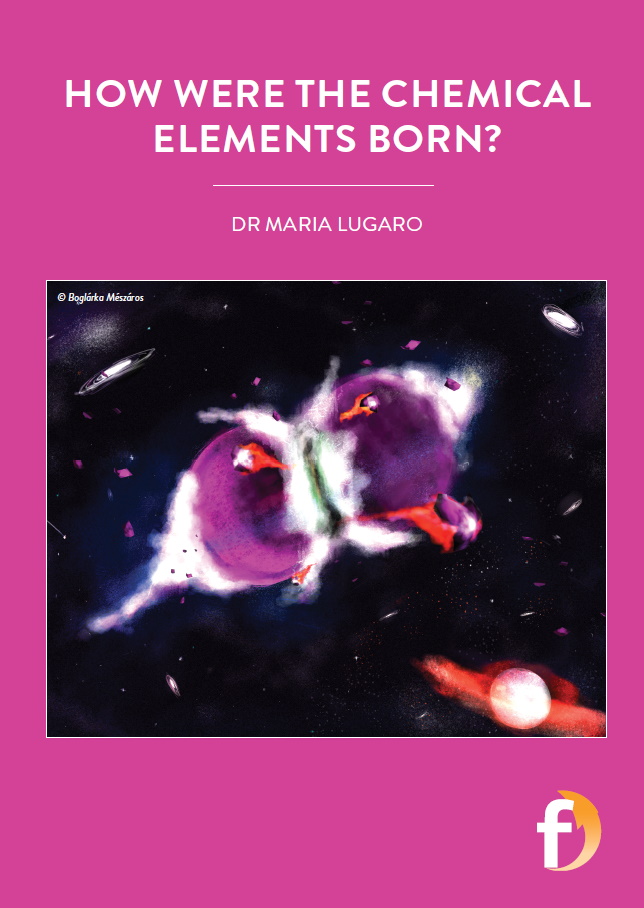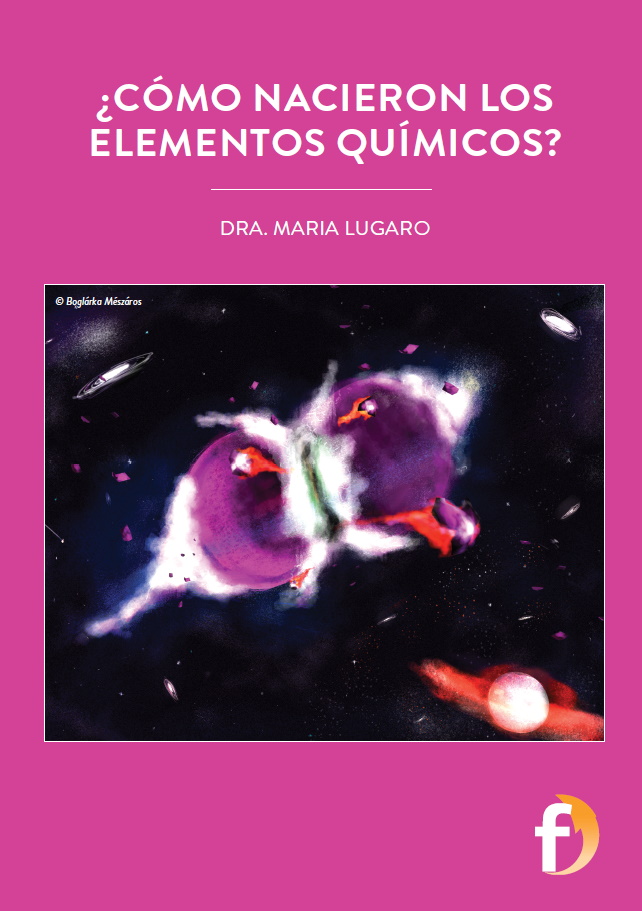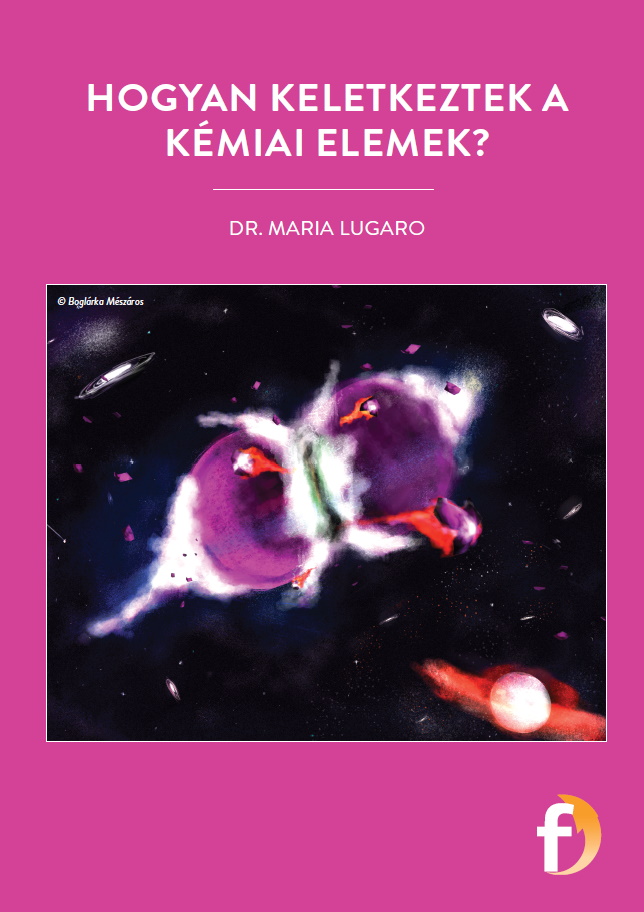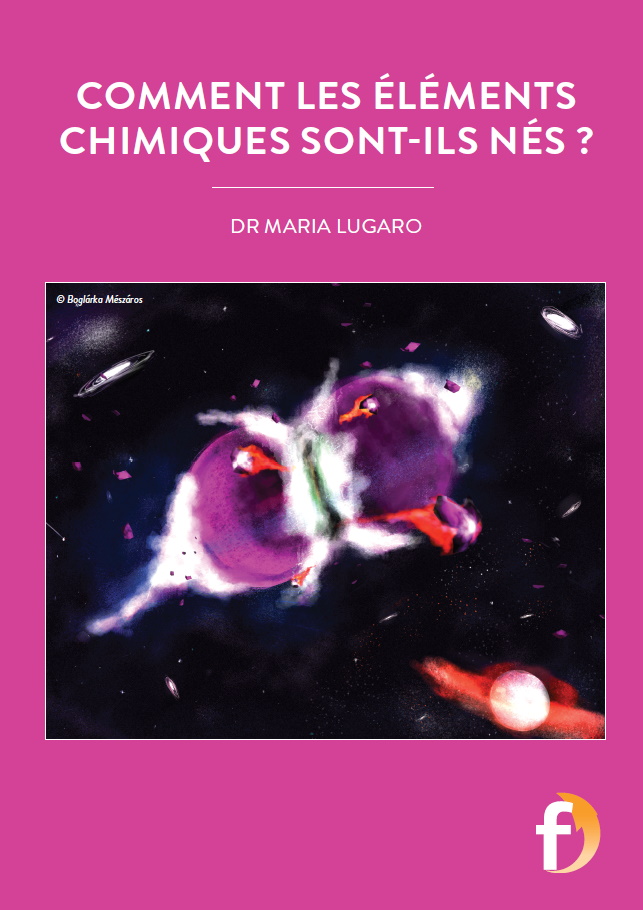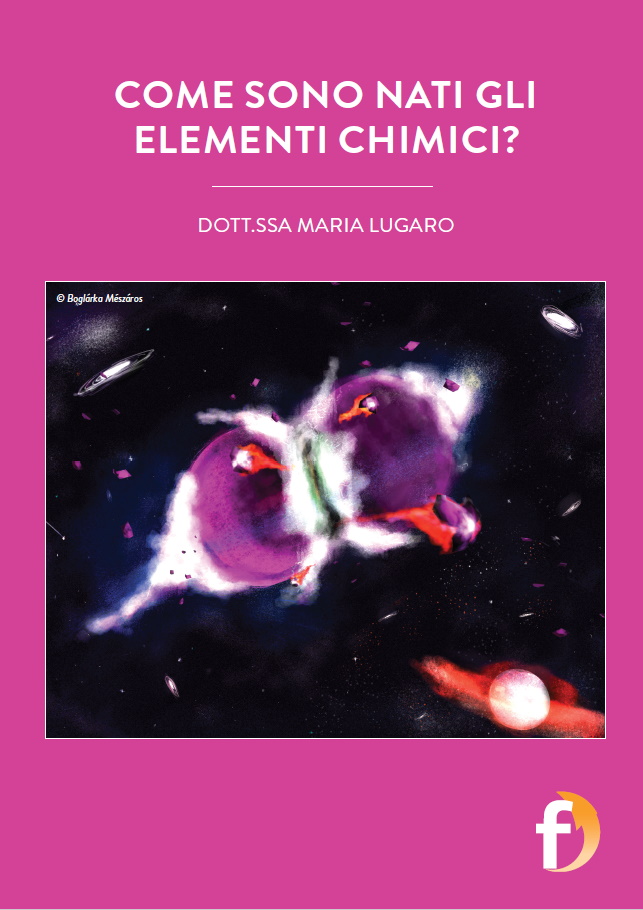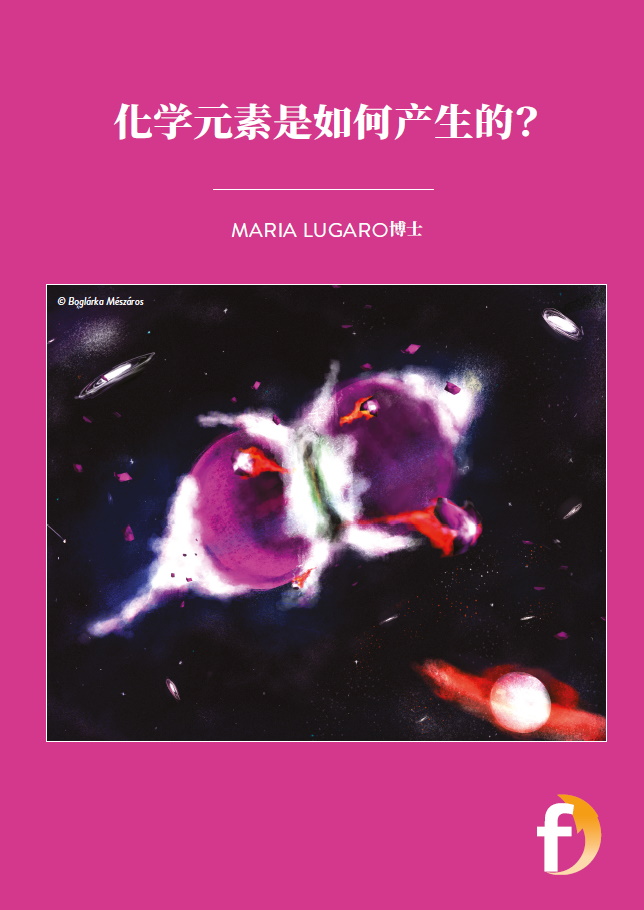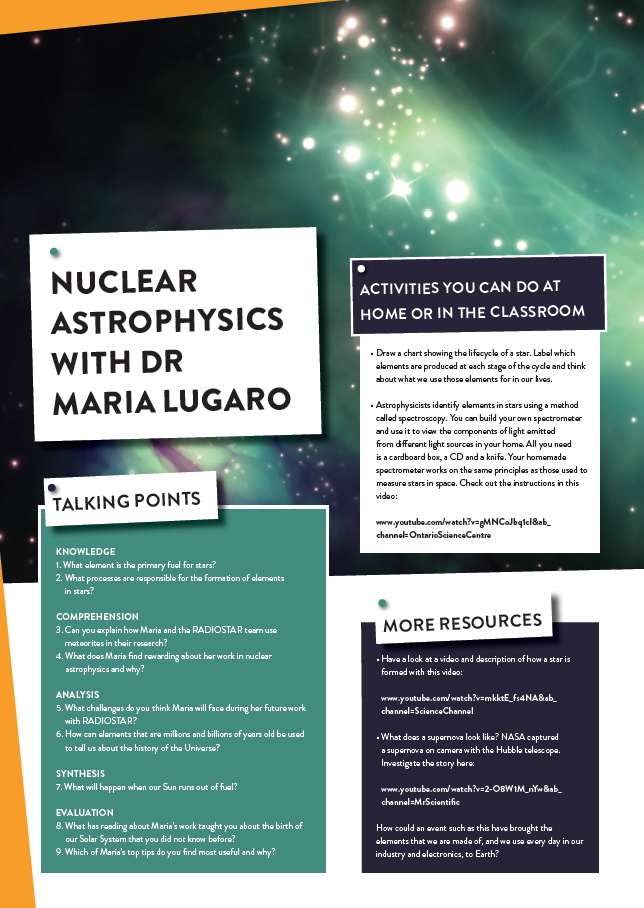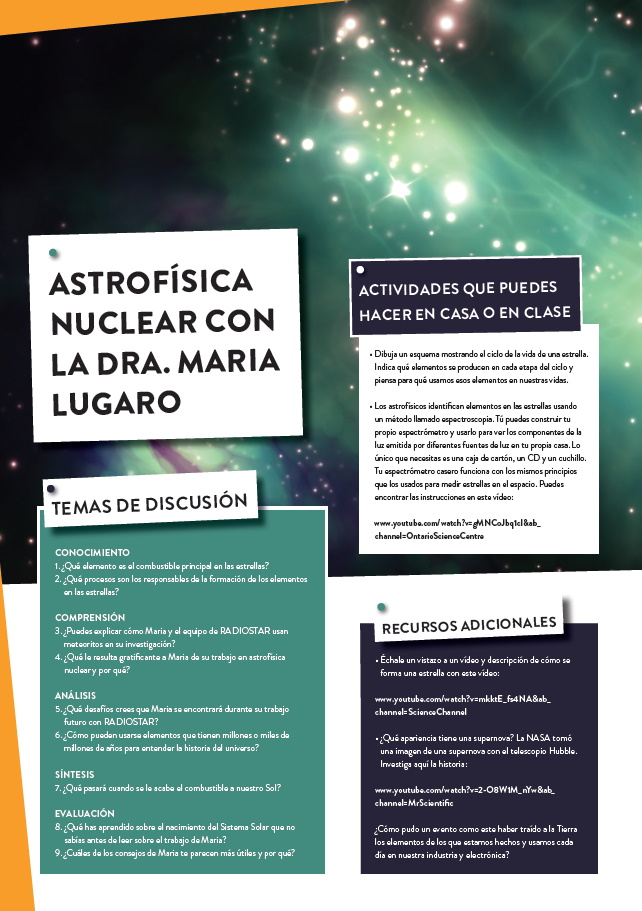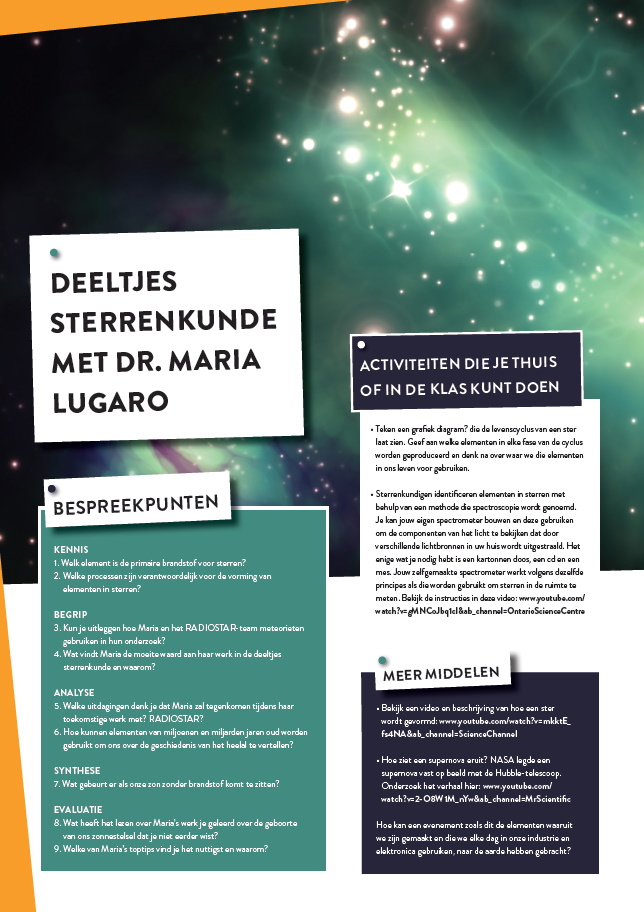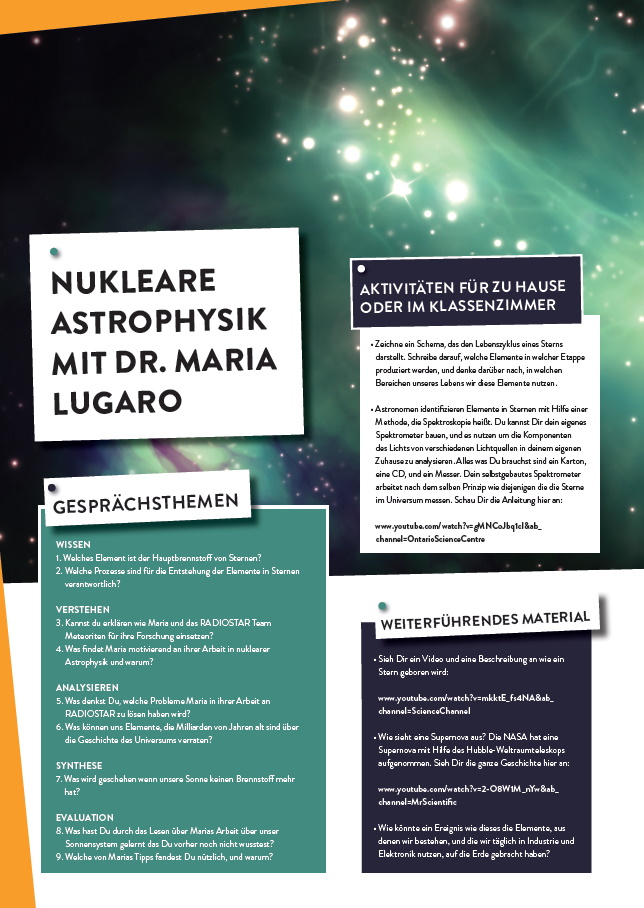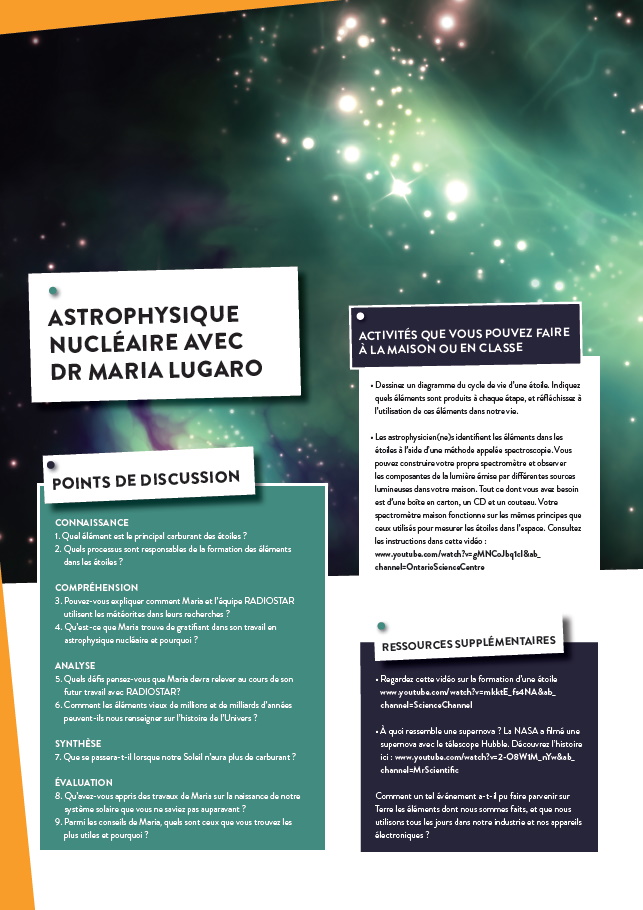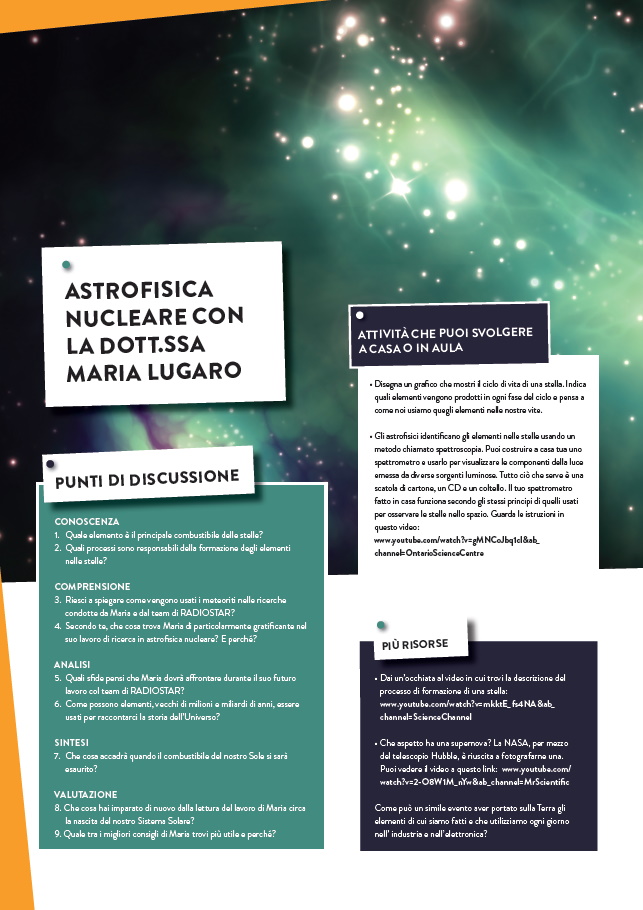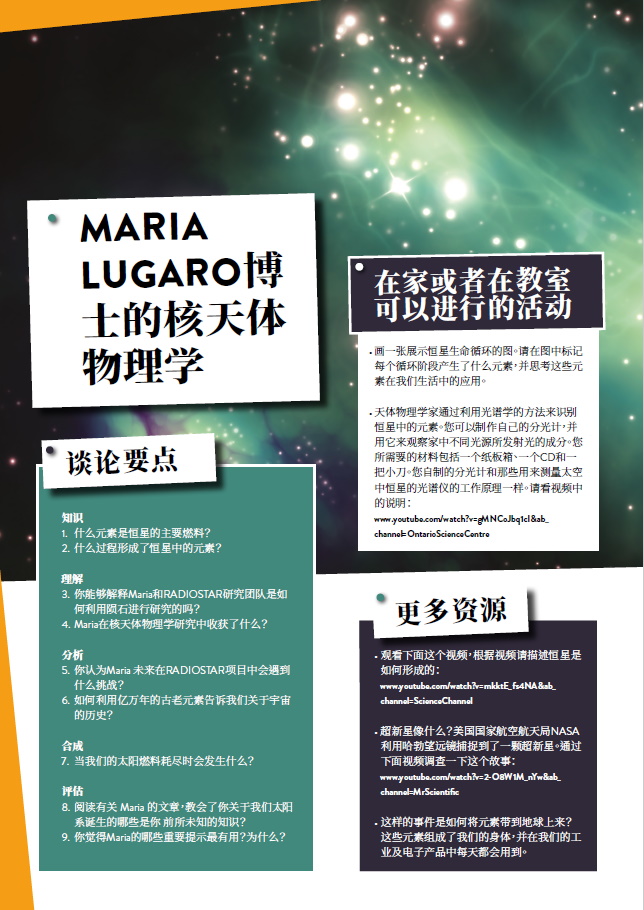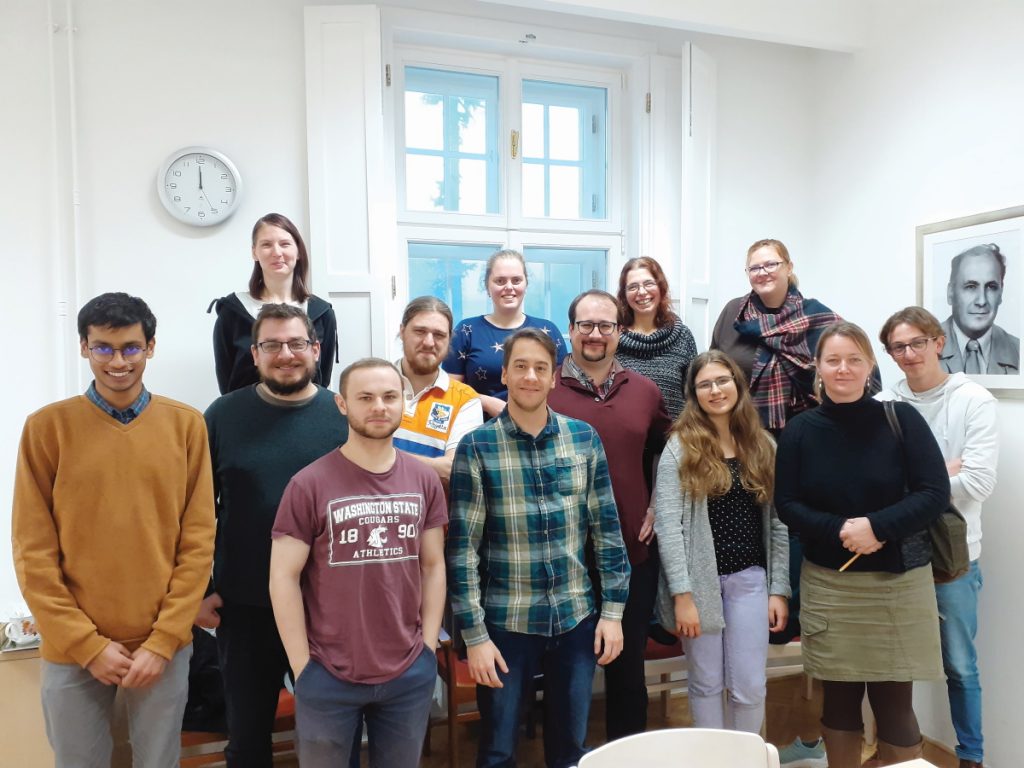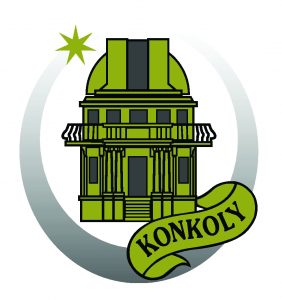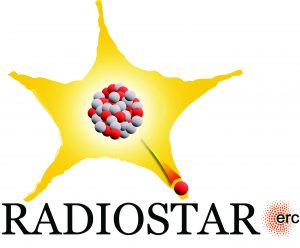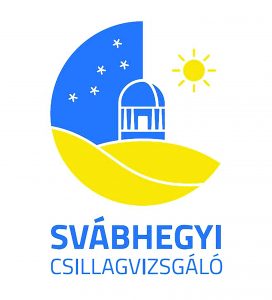How were the chemical elements born?
Stars are a cooking pot for all the naturally occurring chemical elements. Dr Maria Lugaro, of the Konkoly Observatory at the Research Centre for Astronomy and Earth Sciences in Hungary, is working out the stars’ recipes and what they can tell us about the birth of our solar system
TALK LIKE A NUCLEAR ASTROPHYSICIST
ATOMIC NUCLEUS – the core of every atom, made by subatomic particles kept together via the strong nuclear force
NUCLEAR PHYSICS – the study of nuclei and their interactions
NEUTRON – a subatomic particle with no charge
PROTON – a subatomic particle with positive charge
NUCLEAR FUSION – a reaction where one or more atomic nuclei combine to form a heavier nucleus
NEUTRON CAPTURE – when a nucleus captures a neutron to form a heavier nucleus
RADIOACTIVE NUCLEUS – a nucleus that is unstable and decays into another nucleus with a characteristic time
METEORITE – fragment of an asteroid that survives the burning through the atmosphere and lands on the Earth
SUPERNOVA – the explosion of a star due to collapse under gravitational force or runaway nuclear fusion
Once upon a time, just after the Big Bang, most of the elements in the Periodic Table did not exist. All there was in the Universe was hydrogen and helium. From these lightest chemical elements came increasingly heavier species, cooked through the nuclear processes inside stars. Eventually, even the heaviest elements came along through processes like neutron captures, until we reached the variety of chemical elements we know today. The Sun and its Solar System, including our Earth, formed out of a dense cloud of gas and dust made up of all these elements.
Dr Maria Lugaro of the Konkoly Observatory, Research Centre for Astronomy and Earth Sciences in Hungary is a nuclear astrophysicist who has dedicated her career to unravelling some of the mysteries of the complex cascade of physics that brought us from the Big Bang to the Solar System as we know it today. And now, as part of an international and interdisciplinary team of scientists led by the Konkoly Observatory, she is working on the RADIOSTAR project, investigating radioactive nuclei and the clues they left behind in meteorites.
“With RADIOSTAR, we want to understand exactly which cosmic events put radioactive nuclei where the Sun was being born, and the exact timing of such events,” explains Maria. “This is the best way we can understand the history of the matter that we find in the Solar System today and the exact circumstances of the birth of our Sun.”
STAR REACTORS
Stars are burning balls of plasma and ionised gas. The reason they shine so brightly is due to nuclear fusion happening in their cores, where they fuse hydrogen into helium. This process can happen in stars due to the extremity of conditions. Even our Sun, which is a relatively small star compared to some of those out there in the Universe, has a core temperature of 15 million degrees Celsius. In comparison, blast furnaces for melting metals and making steel on Earth only reach around 1500 degrees Celsius!
Hydrogen is essentially food for stars, and when a star begins to run out of this fuel, it starts to fuse heavier and heavier elements. Massive, dying stars running out of hydrogen will start to expand, creating new elements as they go, before they eventually explode in a very luminous supernova, expelling all these elements into space.
“Of the 83 stable and long-lived chemical elements, roughly 80% are heavier than iron,” says Maria. “These are uncommon elements and most of them have strange, sometimes fantastic names, from praseodymium to iridium, and dysprosium to promethium.” RADIOSTAR is aiming to understand how these heavy elements were created in the cosmos.
HEAVY ELEMENTS
Making the heaviest elements is not easy. “How did nature manage to combine very light particles like the helium atomic nucleus, with 2 protons and 2 neutrons, into something heavy like the nucleus of lead with 82 protons and 126 neutrons?” asks Maria.
The answer lies in a process called neutron capture. It has long been known that heavier elements in stars must be created by nuclei capturing neutrons, but how that process works has remained something of a mystery. This is because neutrally-charged neutrons rapidly decay into positively-charged protons with a half-life of about 10 minutes, meaning that free neutrons are difficult to make.
Maria has been particularly fascinated by neutron-capture processes in stars and what their radioactive products can tell us about the history of our Solar System. Especially, she wants to learn about the birth of our Sun from radioactive nuclei made by neutron captures and brought to Earth in meteorites. Information from meteorites tells us how the specific conditions in space and time when our Sun was born resulted in the Solar System we have today. Maria says, “There must have been cosmic events that occurred not too early, yet not too late, and not too far, nor too close, to have produced the exact radioactive mix that was present at the birth of the Sun.”
The RADIOSTAR team can use these radioactive nuclei as clocks, tracing back and determining what the Sun’s original family must have looked like at the moment our Solar System was born. Data from analysis of radioactive elements found in meteorites, using techniques such as mass spectrometry, enables the team to compare the proportions of nuclei of different mass, which, when combined with knowledge of the half-life of each radioactive nucleus, allows calculation of when these elements were produced inside a star or a supernova.
KEY RESULTS
So far, Maria’s results, “strongly suggest that the Sun was born in a large, long-living stellar nursery. Our Sun had many siblings, and different stellar generations born at different times coexisted together in the nursery. Although the Sun left this birth environment a long time ago, this environment strongly shaped its formation and early evolution.”
The work of RADIOSTAR has also revealed that when massive stars exist in orbit with a companion star, they can interact in such a way that they eject more radioactive aluminium than lone stars, and that when a massive star collapses and explodes into a supernova, the dust that is created is very rich in heavy chromium. Now, Maria and the RADIOSTAR team will map all these puzzle pieces together to determine how these nuclei have voyaged across the Galaxy, and what role they have played in shaping our Earth as it looks today.
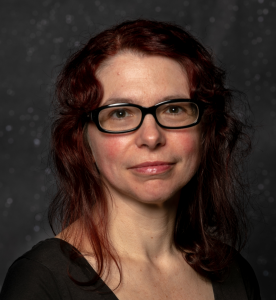 DR MARIA LUGARO
DR MARIA LUGARO
ERC-CoG and Lendület project leader, Konkoly Observatory, Research Centre for Astronomy and Earth Sciences, Eötvös Loránd Research Network, Budapest, Hungary
FIELD OF RESEARCH : Astrophysics
RESEARCH PROJECT : RADIOSTAR: Radioactivities from Stars to Solar Systems.
FUNDER: European Research Council (ERC) ERC-2016-COG – Grant Agreement 724560
ABOUT ASTROPHYSICS
Have you ever looked up into the sky at night and wondered about the nature of all the stars and galaxies you can see? Astrophysics is about understanding all objects in space, from planets to stars, meteorites and galaxies. This includes understanding the physics of how they shine and interact, as well as the physics involved with how they came to be.
Astrophysics is a broad field with many different subdisciplines. Some astrophysicists create computational models, whereas others work at observatories trying to catch a glimpse of faraway planets. One subdiscipline is nuclear astrophysics, an interdisciplinary field that applies theories from nuclear physics to processes in environments in space. Nuclear astrophysicists are interested in the role that nuclear processes play in the lifecycles of stars and the formation of new elements. A lot of this work is focused on the physics of atomic nuclei.
Maria is a nuclear astrophysicist who studies nuclear reactions in stars. She explains, “I like the fact that my work combines different aspects of physics, from the nature of stars and galaxies, to the nuclear physics of the nuclei inside the stars, to the atomic physics in the spectra of stars, and even chemistry and laboratory analysis, when dealing with data from solid meteoritic rocks.” Within such a broad topic, there are always new things to learn and discover. “Even though I have been working in this field for 30 years, I have never stopped learning,” say Maria. “There are always new perspectives to consider and new methods to tackle that bring me far away from my comfort zone. This is challenging and adventurous.”
While Maria is based at Konkoly Observatory in Hungary, the international team behind the RADIOSTAR project and the nature of her work mean Maria collaborates with a wide range of scientists. “I normally work with nuclear physicists,” she says. One such collaborative project (called LUNA) involves measuring nuclear reactions in a laboratory located deep underneath a mountain in Italy. The laboratory has been built more than 1km underground so that the thick layer of rock above it prevents cosmic rays from the Sun interfering with the incredibly sensitive nuclear data that are being collected. “I also work with colleagues who analyse meteoritic rocks,” says Maria, “as well as astronomers who take and interpret stellar spectra.”
Nicholas Butler, an American philosopher, once said, “An expert is one who knows more and more about less and less until he knows absolutely everything about nothing.” Maria disagrees with this. “It is a funny joke,” she says, “but in my experience this does not happen. As I have discovered more about my specific field of neutron captures in stars, I have also had to understand and link this knowledge to its many implications in other fields. So, I have also had to learn about chemistry, dust, meteorites, nuclear reactions, nuclear structure, etc.”
As astrophysicists discover more and more solar planets, a key aim will be to understand our Solar System’s place relative to all the other planetary systems in the Galaxy. This will require greater understanding of the composition of our own Solar System, necessitating further studies of chemical elements, radioactive nuclei, the formation of the Sun and how our Solar System evolved. “The more we try to explore such questions, the more need there is to communicate between different fields,” says Maria. “One of the main challenges for an astrophysicist is to connect your own research to other areas of science, and the next generation of scientists needs to be ready for this.”
EXPLORE A CAREER IN ASTROPHYSICS
• Check out the Royal Astronomic Society’s career resources. They have interviews with people working in the field, and even hold competitions and events you can get involved with.
• Space Careers is a good resource to find out about opportunities like summer schools and astrophysics events.
• Try contacting your local university or, if you have one, observatory to see if they have any work experience opportunities.
• The Konkoly Observatory has a dedicated visitor centre you can visit and has helped organise the International Olympiad of Astronomy and Astrophysics. Maria’s team also takes in high school students for work experience, several of whom have co-authored scientific publications with the group!
PATHWAY FROM SCHOOL TO ASTROPHYSICS
You will need a bachelor’s degree in physics or a related subject such as mathematics, chemistry or natural sciences. Some universities, such as Surrey University in the UK, have dedicated astrophysics with nuclear astrophysics programmes. You can read more here.
A broad undergraduate degree is fine for all areas of science, specialisation is usually done through master and PhD programmes.
HOW DID MARIA BECOME AN ASTROPHYSICIST?
When I was young, I was always interested in dancing, specifically classical ballet, but also flamenco, and I studied dancing from the age of 3 to the age of 16. I wanted to be a dancer, or a dance teacher, but then things clearly went differently. About 10 years ago, I discovered I could still do ballet as an adult to keep fit, so I now have classes every week!
At high school, I studied Latin and ancient Greek, together with history, philosophy, mathematics and physics. At university, I wanted to pursue many topics, from history to political sciences, to physics and mathematics. My mum studied physics and she suggested that I try that. It was hard at the start because I was missing some background, but once I started passing exams with the top marks, I realised I very much enjoyed it, especially the theoretical subjects, from quantum mechanics to relativity. For my thesis, I chose to work in nuclear astrophysics because Professor Roberto Gallino at the University in Torino, my hometown, explained to us students that inside stars and stellar explosions there is a full microscopic world of nuclear reactions, which not only powers starlight but also creates all the chemical elements! He also introduced me to meteorites and how we can use them to understand stars and the Sun, which I found even more fascinating.
I have always been a diligent student, and this is at the basis of any achievement: working very hard. One characteristic that has helped me a lot is that I have a very good memory. As you work, things become more and more complicated and remembering what you and other scientists have done and why, really helps to keep your mind clear and to stay on a meaningful path, instead of going around in circles.
For a scientist, I think humility is like a superpower; it helps you to check your own work rigorously, to be open to new ideas and to accept mistakes, failure, and criticisms, which inevitably come your way. As ballet dancer Margot Fonteyn said, “The one important thing I have learned over the years is the difference between taking one’s work seriously and taking oneself seriously. The first is imperative and the second is disastrous.”
I practise mindfulness twice a day and I try to avoid work and thinking about work out of work hours. The brain needs to rest to be able to keep on working at full efficiency. It is not easy to switch off, which is why I am trying to be more in control of what I think about, using the mindfulness practice. Luckily, I have a large family who helps distract me. I schedule three weeks of continuous holiday every summer, when I do not even check my emails. When those are finished, I always feel I have re-found who I am and can start having fun with science again!
MARIA’S TOP TIPS
01 Perseverance is a crucial skill to develop. Challenging yourself with harder tasks and being willing to stick to them is a way to get better at persevering and can help you enjoy your studies and work even more.
02 Read a lot and train your memory. Scientists need to read constantly to keep up to date with what is happening in their field and a good memory helps you not get lost in a labyrinth of old and new ideas.
03 Don’t be scared of mistakes. Challenging yourself in your studies and in science is all about learning to accept your mistakes and failures and keep going.
Reference
https://doi.org/10.33424/FUTURUM153
ATOMIC NUCLEUS – the core of every atom, made by subatomic particles kept together via the strong nuclear force
NUCLEAR PHYSICS – the study of nuclei and their interactions
NEUTRON – a subatomic particle with no charge
PROTON – a subatomic particle with positive charge
NUCLEAR FUSION – a reaction where one or more atomic nuclei combine to form a heavier nucleus
NEUTRON CAPTURE – when a nucleus captures a neutron to form a heavier nucleus
RADIOACTIVE NUCLEUS – a nucleus that is unstable and decays into another nucleus with a characteristic time
METEORITE – fragment of an asteroid that survives the burning through the atmosphere and lands on the Earth
SUPERNOVA – the explosion of a star due to collapse under gravitational force or runaway nuclear fusion
Once upon a time, just after the Big Bang, most of the elements in the Periodic Table did not exist. All there was in the Universe was hydrogen and helium. From these lightest chemical elements came increasingly heavier species, cooked through the nuclear processes inside stars. Eventually, even the heaviest elements came along through processes like neutron captures, until we reached the variety of chemical elements we know today. The Sun and its Solar System, including our Earth, formed out of a dense cloud of gas and dust made up of all these elements.
Dr Maria Lugaro of the Konkoly Observatory, Research Centre for Astronomy and Earth Sciences in Hungary is a nuclear astrophysicist who has dedicated her career to unravelling some of the mysteries of the complex cascade of physics that brought us from the Big Bang to the Solar System as we know it today. And now, as part of an international and interdisciplinary team of scientists led by the Konkoly Observatory, she is working on the RADIOSTAR project, investigating radioactive nuclei and the clues they left behind in meteorites.
“With RADIOSTAR, we want to understand exactly which cosmic events put radioactive nuclei where the Sun was being born, and the exact timing of such events,” explains Maria. “This is the best way we can understand the history of the matter that we find in the Solar System today and the exact circumstances of the birth of our Sun.”
STAR REACTORS
Stars are burning balls of plasma and ionised gas. The reason they shine so brightly is due to nuclear fusion happening in their cores, where they fuse hydrogen into helium. This process can happen in stars due to the extremity of conditions. Even our Sun, which is a relatively small star compared to some of those out there in the Universe, has a core temperature of 15 million degrees Celsius. In comparison, blast furnaces for melting metals and making steel on Earth only reach around 1500 degrees Celsius!
Hydrogen is essentially food for stars, and when a star begins to run out of this fuel, it starts to fuse heavier and heavier elements. Massive, dying stars running out of hydrogen will start to expand, creating new elements as they go, before they eventually explode in a very luminous supernova, expelling all these elements into space.
“Of the 83 stable and long-lived chemical elements, roughly 80% are heavier than iron,” says Maria. “These are uncommon elements and most of them have strange, sometimes fantastic names, from praseodymium to iridium, and dysprosium to promethium.” RADIOSTAR is aiming to understand how these heavy elements were created in the cosmos.
HEAVY ELEMENTS
Making the heaviest elements is not easy. “How did nature manage to combine very light particles like the helium atomic nucleus, with 2 protons and 2 neutrons, into something heavy like the nucleus of lead with 82 protons and 126 neutrons?” asks Maria.
The answer lies in a process called neutron capture. It has long been known that heavier elements in stars must be created by nuclei capturing neutrons, but how that process works has remained something of a mystery. This is because neutrally-charged neutrons rapidly decay into positively-charged protons with a half-life of about 10 minutes, meaning that free neutrons are difficult to make.
Maria has been particularly fascinated by neutron-capture processes in stars and what their radioactive products can tell us about the history of our Solar System. Especially, she wants to learn about the birth of our Sun from radioactive nuclei made by neutron captures and brought to Earth in meteorites. Information from meteorites tells us how the specific conditions in space and time when our Sun was born resulted in the Solar System we have today. Maria says, “There must have been cosmic events that occurred not too early, yet not too late, and not too far, nor too close, to have produced the exact radioactive mix that was present at the birth of the Sun.”
The RADIOSTAR team can use these radioactive nuclei as clocks, tracing back and determining what the Sun’s original family must have looked like at the moment our Solar System was born. Data from analysis of radioactive elements found in meteorites, using techniques such as mass spectrometry, enables the team to compare the proportions of nuclei of different mass, which, when combined with knowledge of the half-life of each radioactive nucleus, allows calculation of when these elements were produced inside a star or a supernova.
KEY RESULTS
So far, Maria’s results, “strongly suggest that the Sun was born in a large, long-living stellar nursery. Our Sun had many siblings, and different stellar generations born at different times coexisted together in the nursery. Although the Sun left this birth environment a long time ago, this environment strongly shaped its formation and early evolution.”
The work of RADIOSTAR has also revealed that when massive stars exist in orbit with a companion star, they can interact in such a way that they eject more radioactive aluminium than lone stars, and that when a massive star collapses and explodes into a supernova, the dust that is created is very rich in heavy chromium. Now, Maria and the RADIOSTAR team will map all these puzzle pieces together to determine how these nuclei have voyaged across the Galaxy, and what role they have played in shaping our Earth as it looks today.
 DR MARIA LUGARO
DR MARIA LUGARO
ERC-CoG and Lendület project leader, Konkoly Observatory, Research Centre for Astronomy and Earth Sciences, Eötvös Loránd Research Network, Budapest, Hungary
FIELD OF RESEARCH : Astrophysics
RESEARCH PROJECT : RADIOSTAR: Radioactivities from Stars to Solar Systems.
FUNDER: European Research Council (ERC) ERC-2016-COG – Grant Agreement 724560
Have you ever looked up into the sky at night and wondered about the nature of all the stars and galaxies you can see? Astrophysics is about understanding all objects in space, from planets to stars, meteorites and galaxies. This includes understanding the physics of how they shine and interact, as well as the physics involved with how they came to be.
Astrophysics is a broad field with many different subdisciplines. Some astrophysicists create computational models, whereas others work at observatories trying to catch a glimpse of faraway planets. One subdiscipline is nuclear astrophysics, an interdisciplinary field that applies theories from nuclear physics to processes in environments in space. Nuclear astrophysicists are interested in the role that nuclear processes play in the lifecycles of stars and the formation of new elements. A lot of this work is focused on the physics of atomic nuclei.
Maria is a nuclear astrophysicist who studies nuclear reactions in stars. She explains, “I like the fact that my work combines different aspects of physics, from the nature of stars and galaxies, to the nuclear physics of the nuclei inside the stars, to the atomic physics in the spectra of stars, and even chemistry and laboratory analysis, when dealing with data from solid meteoritic rocks.” Within such a broad topic, there are always new things to learn and discover. “Even though I have been working in this field for 30 years, I have never stopped learning,” say Maria. “There are always new perspectives to consider and new methods to tackle that bring me far away from my comfort zone. This is challenging and adventurous.”
While Maria is based at Konkoly Observatory in Hungary, the international team behind the RADIOSTAR project and the nature of her work mean Maria collaborates with a wide range of scientists. “I normally work with nuclear physicists,” she says. One such collaborative project (called LUNA) involves measuring nuclear reactions in a laboratory located deep underneath a mountain in Italy. The laboratory has been built more than 1km underground so that the thick layer of rock above it prevents cosmic rays from the Sun interfering with the incredibly sensitive nuclear data that are being collected. “I also work with colleagues who analyse meteoritic rocks,” says Maria, “as well as astronomers who take and interpret stellar spectra.”
Nicholas Butler, an American philosopher, once said, “An expert is one who knows more and more about less and less until he knows absolutely everything about nothing.” Maria disagrees with this. “It is a funny joke,” she says, “but in my experience this does not happen. As I have discovered more about my specific field of neutron captures in stars, I have also had to understand and link this knowledge to its many implications in other fields. So, I have also had to learn about chemistry, dust, meteorites, nuclear reactions, nuclear structure, etc.”
As astrophysicists discover more and more solar planets, a key aim will be to understand our Solar System’s place relative to all the other planetary systems in the Galaxy. This will require greater understanding of the composition of our own Solar System, necessitating further studies of chemical elements, radioactive nuclei, the formation of the Sun and how our Solar System evolved. “The more we try to explore such questions, the more need there is to communicate between different fields,” says Maria. “One of the main challenges for an astrophysicist is to connect your own research to other areas of science, and the next generation of scientists needs to be ready for this.”
EXPLORE A CAREER IN ASTROPHYSICS
• Check out the Royal Astronomic Society’s career resources. They have interviews with people working in the field, and even hold competitions and events you can get involved with.
• Space Careers is a good resource to find out about opportunities like summer schools and astrophysics events.
• Try contacting your local university or, if you have one, observatory to see if they have any work experience opportunities.
• The Konkoly Observatory has a dedicated visitor centre you can visit and has helped organise the International Olympiad of Astronomy and Astrophysics. Maria’s team also takes in high school students for work experience, several of whom have co-authored scientific publications with the group!
PATHWAY FROM SCHOOL TO ASTROPHYSICS
You will need a bachelor’s degree in physics or a related subject such as mathematics, chemistry or natural sciences. Some universities, such as Surrey University in the UK, have dedicated astrophysics with nuclear astrophysics programmes. You can read more here.
A broad undergraduate degree is fine for all areas of science, specialisation is usually done through master and PhD programmes.
HOW DID MARIA BECOME AN ASTROPHYSICIST?
When I was young, I was always interested in dancing, specifically classical ballet, but also flamenco, and I studied dancing from the age of 3 to the age of 16. I wanted to be a dancer, or a dance teacher, but then things clearly went differently. About 10 years ago, I discovered I could still do ballet as an adult to keep fit, so I now have classes every week!
At high school, I studied Latin and ancient Greek, together with history, philosophy, mathematics and physics. At university, I wanted to pursue many topics, from history to political sciences, to physics and mathematics. My mum studied physics and she suggested that I try that. It was hard at the start because I was missing some background, but once I started passing exams with the top marks, I realised I very much enjoyed it, especially the theoretical subjects, from quantum mechanics to relativity. For my thesis, I chose to work in nuclear astrophysics because Professor Roberto Gallino at the University in Torino, my hometown, explained to us students that inside stars and stellar explosions there is a full microscopic world of nuclear reactions, which not only powers starlight but also creates all the chemical elements! He also introduced me to meteorites and how we can use them to understand stars and the Sun, which I found even more fascinating.
I have always been a diligent student, and this is at the basis of any achievement: working very hard. One characteristic that has helped me a lot is that I have a very good memory. As you work, things become more and more complicated and remembering what you and other scientists have done and why, really helps to keep your mind clear and to stay on a meaningful path, instead of going around in circles.
For a scientist, I think humility is like a superpower; it helps you to check your own work rigorously, to be open to new ideas and to accept mistakes, failure, and criticisms, which inevitably come your way. As ballet dancer Margot Fonteyn said, “The one important thing I have learned over the years is the difference between taking one’s work seriously and taking oneself seriously. The first is imperative and the second is disastrous.”
I practise mindfulness twice a day and I try to avoid work and thinking about work out of work hours. The brain needs to rest to be able to keep on working at full efficiency. It is not easy to switch off, which is why I am trying to be more in control of what I think about, using the mindfulness practice. Luckily, I have a large family who helps distract me. I schedule three weeks of continuous holiday every summer, when I do not even check my emails. When those are finished, I always feel I have re-found who I am and can start having fun with science again!
MARIA’S TOP TIPS
01 Perseverance is a crucial skill to develop. Challenging yourself with harder tasks and being willing to stick to them is a way to get better at persevering and can help you enjoy your studies and work even more.
02 Read a lot and train your memory. Scientists need to read constantly to keep up to date with what is happening in their field and a good memory helps you not get lost in a labyrinth of old and new ideas.
03 Don’t be scared of mistakes. Challenging yourself in your studies and in science is all about learning to accept your mistakes and failures and keep going.
Write it in the comments box below and Maria will get back to you. (Remember, researchers are very busy people, so you may have to wait a few days.)

